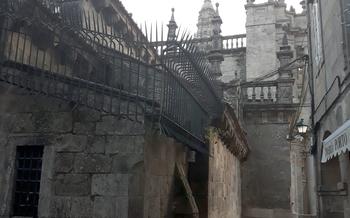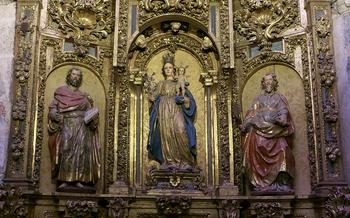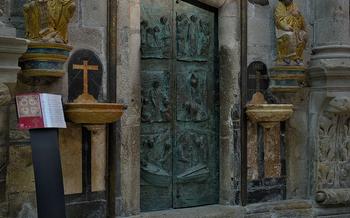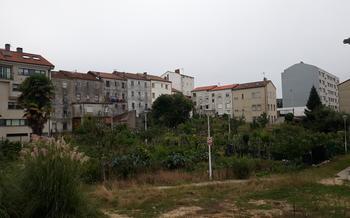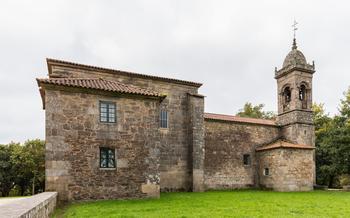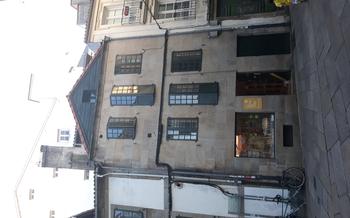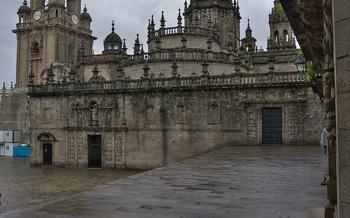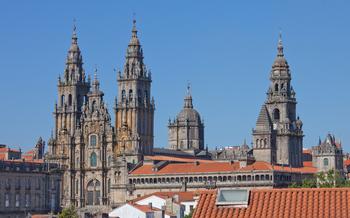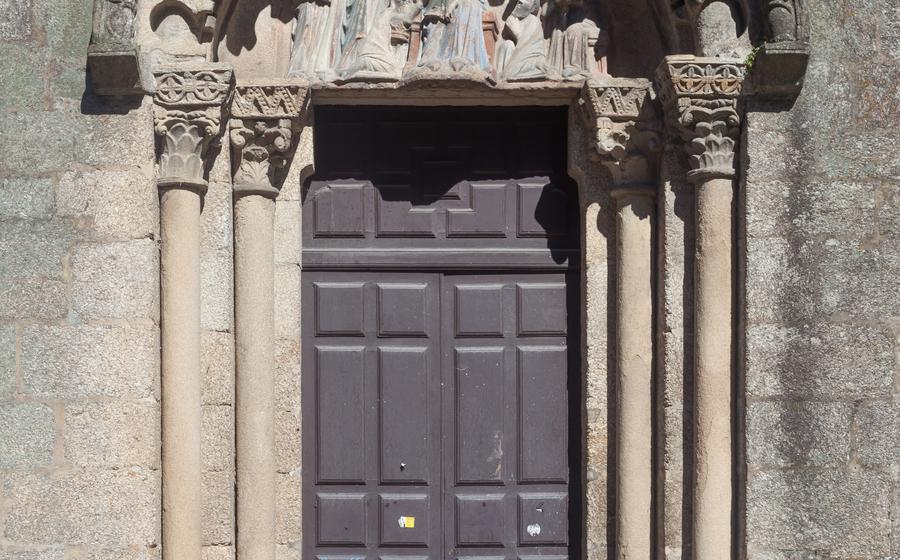
Church of San Fiz de Solovio
- Year of Construction, Architectural Style, Key Events, and Religious Significance
- Location of the Church
- Architectural Highlights
- Religious Significance
- Visiting Hours and Admission
- Highlights of the Interior
- Exploring the Surroundings
- Tips for Photography Enthusiasts
- Stories and Legends
- Pilgrimage Route to Santiago
- Preservation and Conservation
- Community Involvement
- Accessibility for Visitors with Disabilities
- Insider Tip: Hidden Gem
Year of Construction, Architectural Style, Key Events, and Religious Significance
The Church of San Fiz de Solovio, also known as San Fiz de Solovio, stands as a testament to the rich architectural heritage of Santiago de Compostela. Its construction dates back to the 12th century, a period characterized by the Romanesque architectural style that dominated much of Europe during that era. The church's design showcases the distinctive features of Romanesque architecture, including its sturdy structure, rounded arches, and intricate carvings that adorn its exterior and interior spaces.
Throughout its history, the Church of San Fiz de Solovio has witnessed several significant events and played a pivotal role in the religious landscape of Santiago de Compostela. One of the most notable events associated with the church is the visit of Saint Francis of Assisi in the 13th century. The presence of this iconic saint left an enduring mark on the church's history and contributed to its growing reputation as a place of pilgrimage and devotion.
In terms of religious significance, the Church of San Fiz de Solovio holds a special place in the hearts of the local community and pilgrims alike. It is dedicated to Saint Fiz, a revered figure in the Catholic tradition known for his unwavering faith and devotion. The church serves as a center for worship, spiritual reflection, and community gatherings, fostering a sense of unity and belonging among the faithful.
Location of the Church
The Church of San Fiz de Solovio is nestled in the heart of Santiago de Compostela's historic center, a UNESCO World Heritage Site. It is situated on Rúa San Fiz de Solovio, a narrow cobbled street that leads to the iconic Plaza del Obradoiro, where the majestic Santiago de Compostela Cathedral stands. The church is surrounded by a charming neighborhood filled with traditional Galician architecture, lively cafes, and souvenir shops.
The Church of San Fiz de Solovio is easily accessible by foot from any point within the city center. It is also well-connected by public transportation, with several bus lines stopping nearby. The closest bus stop is "Praza de Galicia," which is just a short walk from the church.
Architectural Highlights
The Church of San Fiz de Solovio boasts a captivating architectural style that blends Romanesque and Gothic elements. Its exterior features a sturdy granite facade adorned with intricate carvings and sculptures depicting biblical scenes and figures. The main entrance, known as the Puerta del Sol, is particularly noteworthy for its elaborate tympanum, which showcases a mesmerizing depiction of Christ in Majesty surrounded by the four evangelists.
Inside the church, visitors are greeted by a spacious and awe-inspiring interior. The nave is divided into three aisles by rows of slender columns, creating a sense of grandeur and verticality. The vaulted ceilings are adorned with intricate rib patterns and decorative bosses, adding to the church's rich visual appeal. Notable architectural elements include the beautifully carved choir stalls, the ornate pulpit, and the impressive main altar, which features a stunning altarpiece depicting scenes from the life of Jesus.
The church's symbolism and iconography are deeply rooted in Christian tradition. The scallop shell, a symbol of pilgrimage, can be found throughout the church, reminding visitors of the significance of the Camino de Santiago. Other recurring motifs include the cross, the lamb, and the dove, which represent the sacrifice, innocence, and peace associated with Christianity.
Religious Significance
The Church of San Fiz de Solovio holds a profound religious significance, deeply entwined with the history of Christianity in Spain. It is dedicated to Saint Fiz, a local martyr believed to have been a disciple of Saint James the Great, one of Jesus' twelve apostles. Saint Fiz is revered as the patron saint of the church, and his feast day is celebrated annually on July 25th with great devotion and festivities.
Throughout the year, the church serves as a vibrant center for religious observances and events. Regular masses and prayer services are held, attracting a dedicated congregation from the local community. During special religious festivals, the church transforms into a hub of activity, with processions, choirs, and colorful displays filling its hallowed halls.
Furthermore, the Church of San Fiz de Solovio plays a pivotal role in the pilgrimage traditions associated with the Camino de Santiago. As a designated stop along the ancient pilgrimage route, the church provides shelter, guidance, and spiritual sustenance to weary pilgrims making their way to the Cathedral of Santiago de Compostela. The presence of the church along the pilgrimage route underscores its importance as a sacred destination, offering pilgrims a chance to reflect, pray, and seek blessings on their journey.
Visiting Hours and Admission
The Church of San Fiz de Solovio welcomes visitors with open arms, offering ample opportunities for exploration and reflection. Its regular visiting hours align with the needs of pilgrims and tourists alike, allowing ample time to soak in its beauty and spiritual significance. During these hours, visitors are free to roam the church's serene interior, marvel at its architectural wonders, and immerse themselves in its sacred atmosphere.
While admission to the church is free of charge, visitors are encouraged to make a donation to support its ongoing maintenance and preservation. These donations play a crucial role in ensuring that this architectural and spiritual treasure remains a beacon of faith and inspiration for generations to come.
Guided tours are available for those seeking a deeper understanding of the church's history, symbolism, and religious significance. Led by knowledgeable guides, these tours provide an immersive experience that unveils the hidden stories and meanings embedded within the church's walls.
Highlights of the Interior
Step inside the Church of San Fiz de Solovio and prepare to be captivated by its stunning interior. The main altar, a masterpiece of Baroque artistry, takes center stage, adorned with intricate carvings, gleaming gold leaf, and a resplendent altarpiece depicting scenes from the life of Saint Fiz. Admire the meticulous attention to detail, from the delicate cherubs to the intricate floral motifs.
Among the church's notable works of art, don't miss the exquisite statue of Saint Fiz, patron saint of the church. Carved from fine wood and adorned with intricate details, this life-size sculpture exudes both majesty and serenity. Gaze upon the saint's serene countenance and feel a sense of peace and tranquility wash over you.
The church is also home to a collection of stunning stained glass windows, each a masterpiece of color and light. As the sunlight streams through the intricately designed glass, the interior is bathed in a kaleidoscope of hues, creating an ethereal and awe-inspiring atmosphere. Take a moment to admire the biblical scenes depicted in the windows, each telling a story from the life of Christ or the saints.
Finally, keep an eye out for the unique and unusual features that make this church stand out. Perhaps you'll spot a hidden symbol or a curious architectural detail that hints at the church's rich history. These hidden gems add to the charm and intrigue of the Church of San Fiz de Solovio, making it a truly special place to visit.
Exploring the Surroundings
The Church of San Fiz de Solovio is nestled in the charming neighborhood of San Fiz, just a short walk from the historic center of Santiago de Compostela. The area is steeped in history and culture, with narrow cobblestone streets, traditional Galician architecture, and a vibrant atmosphere.
Within easy walking distance from the church, visitors can explore several notable landmarks, including the Parque de la Alameda, a beautiful public garden with centuries-old trees and a picturesque pond. The Museo do Pobo Galego, dedicated to Galician history and culture, offers a fascinating glimpse into the region's rich heritage.
For a unique perspective of the city, visitors can climb to the top of the Torre de la Berenguela, an 11th-century tower that offers panoramic views of Santiago de Compostela and the surrounding countryside.
The area surrounding the Church of San Fiz de Solovio is also a culinary paradise, with a wide range of restaurants, cafés, and tapas bars serving traditional Galician cuisine. Visitors can indulge in mouthwatering dishes such as pulpo a la gallega (octopus), empanadas (stuffed pastries), and tarta de Santiago (almond cake).
Whether you're interested in history, culture, gastronomy, or simply soaking up the local atmosphere, the surroundings of the Church of San Fiz de Solovio offer something for everyone. Take some time to wander the streets, visit the nearby attractions, and savor the unique charm of this historic neighborhood.
Tips for Photography Enthusiasts
San Fiz de Solovio's captivating architecture and intricate interior design present a photographer's paradise. For capturing the church's grandeur, position yourself at a slight distance to fit its full height into the frame. Utilize the morning or late afternoon sunlight to highlight the church's warm stone facade. Inside, focus on the intricate carvings, frescoes, and stained glass windows, using natural light to accentuate their details. Experiment with different angles to capture the interplay of light and shadow, creating a sense of depth and mystery. For a unique perspective, climb the bell tower for a panoramic view of the surrounding landscape. Remember to respect the sanctity of the church and avoid disturbing worshippers during religious services.
Stories and Legends
The church of San Fiz de Solovio is steeped in history and legend. According to local folklore, the church was built on the site of a pagan temple dedicated to the Celtic god of the sun, Lugh. It is said that when the Christian missionaries arrived in the area, they found the temple deserted and decided to build a church on the same spot.
Another legend tells the story of a young woman named Solovia who was martyred on the site of the church. According to the legend, Solovia was a beautiful Christian woman who was kidnapped by a group of pagan bandits. She refused to renounce her faith, and the bandits killed her. Her body was found by a group of Christians who buried her on the site of the church.
The church of San Fiz de Solovio has also been the site of many miracles. In the 17th century, a young boy who was blind was miraculously cured after praying to Saint Fiz. In the 18th century, a woman who was dying of cancer was miraculously cured after drinking water from the church's fountain.
These are just a few of the many stories and legends that are associated with the church of San Fiz de Solovio. These stories add to the church's mystique and make it a popular destination for pilgrims and tourists alike.
Pilgrimage Route to Santiago
The Church of San Fiz de Solovio holds a significant position on the Camino de Santiago, a renowned pilgrimage route that attracts thousands of faithful trekkers each year. For centuries, pilgrims have sought solace and guidance within the church's hallowed walls as they journey towards the revered Cathedral of Santiago de Compostela. The church's location along this historic route has transformed it into a haven for weary pilgrims, providing shelter, sustenance, and spiritual encouragement.
The pilgrimage to Santiago de Compostela is not merely a physical journey but a profound spiritual odyssey. Pilgrims from all walks of life embark on this transformative experience, seeking renewal, forgiveness, and a deeper connection with their faith. The church, with its serene atmosphere and rich religious symbolism, offers a sanctuary for pilgrims to pause, reflect, and find strength for the road ahead.
As pilgrims approach the church, they are greeted by the iconic scallop shell, a symbol deeply entwined with the Camino de Santiago. The scallop shell, often worn by pilgrims as a symbol of their journey, represents the trials and tribulations they have endured along the way. It serves as a reminder of the challenges they have overcome and the spiritual growth they have experienced.
Upon entering the church, pilgrims are enveloped in an aura of peace and tranquility. The gentle glow of candles illuminates the interior, casting a warm, inviting light on the sacred space. The walls are adorned with intricate carvings and frescoes depicting scenes from the Bible, providing a visual narrative of faith and devotion.
For pilgrims, the Church of San Fiz de Solovio is more than just a resting point; it is a place of profound spiritual connection. Here, they can seek solace in prayer, find guidance from the local clergy, and share stories of their pilgrimage experiences with fellow travelers. The church's significance extends far beyond its architectural beauty, as it represents the essence of the Camino de Santiago: a journey of faith, resilience, and the pursuit of spiritual enlightenment.
Preservation and Conservation
The church of San Fiz de Solovio, a testament to the architectural and religious heritage of Santiago de Compostela, has undergone meticulous preservation and restoration efforts over the years. Recognizing the immense value of this sacred space, dedicated teams of conservators and historians have worked tirelessly to maintain its historical integrity while ensuring its accessibility to future generations.
One of the primary challenges faced by conservators is the preservation of the church's original architectural features. The ravages of time, environmental factors, and past renovations have necessitated careful interventions to restore the church's exterior and interior to their former glory. This delicate work involves employing traditional techniques and materials to ensure that any repairs or modifications blend seamlessly with the existing fabric of the building.
In addition to structural preservation, conservators also focus on the conservation of the church's priceless artworks and religious artifacts. These include intricate carvings, paintings, and sculptures that adorn the interior of the church. Specialized conservators, skilled in the restoration of religious artifacts, work tirelessly to preserve these treasures, ensuring that they continue to inspire and captivate visitors for generations to come.
The preservation of religious heritage is not merely a matter of preserving physical structures but also maintaining the spiritual and cultural significance they embody. The church of San Fiz de Solovio, as a living testament to the enduring power of faith, serves as a reminder of the importance of safeguarding our shared cultural heritage for generations to come.
Visitors to the church can play a vital role in preserving this sacred space by respecting its sanctity and adhering to any guidelines set forth by the church authorities. By refraining from touching or leaning against delicate artworks and by following designated pathways, visitors can help ensure that this architectural and religious treasure remains pristine for all to appreciate.
Community Involvement
The Church of San Fiz de Solovio plays a pivotal role in the fabric of the local community. It serves as a spiritual and cultural hub, fostering a deep sense of belonging and togetherness. Beyond its religious significance, the church actively engages in social and charitable initiatives that positively impact the lives of those in need. Visitors to the church have the opportunity to contribute to these initiatives and give back to the community. By supporting local soup kitchens, food drives, or community organizations, visitors can make a meaningful difference and leave a lasting impact long after their visit. Embracing the spirit of community involvement not only enriches the visitor's experience but also demonstrates the profound role that religious institutions play in fostering social cohesion and well-being.
Accessibility for Visitors with Disabilities
The Church of San Fiz de Solovio strives to ensure accessibility and inclusivity for visitors of all abilities.
- Designated parking spaces for visitors with disabilities are available near the church.
- The church entrance is wheelchair-accessible, with ramps or elevators provided for easy access.
- Inside the church, there are wide aisles and accessible seating areas to accommodate wheelchairs and mobility devices.
- Assistive listening devices or closed captioning may be available for visitors with hearing impairments.
- Staff members or volunteers are trained to assist visitors with disabilities and provide any necessary support or guidance.
The church welcomes visitors to contact them in advance if they have any specific accessibility needs or concerns, and they will do their utmost to accommodate requests and ensure a comfortable and enjoyable visit for all.
Insider Tip: Hidden Gem
Within the Church of San Fiz de Solovio, there lies a hidden gem that often goes unnoticed by visitors. Tucked away in a small alcove near the main altar, you'll find a stunningly detailed triptych depicting scenes from the life of Saint Francis of Assisi. Created in the 15th century, this intricate masterpiece is a testament to the artistic skill and devotion of the era. The vibrant colors and expressive figures bring the stories of Saint Francis to life, offering visitors a glimpse into the rich history and artistry of the church. Don't miss this hidden treasure when exploring the wonders of the Church of San Fiz de Solovio.
